Japanese Empire Worksheets
Do you want to save dozens of hours in time? Get your evenings and weekends back? Be able to teach about the Japanese Empire to your students?
Our worksheet bundle includes a fact file and printable worksheets and student activities. Perfect for both the classroom and homeschooling!
Resource Examples
Click any of the example images below to view a larger version.
Fact File
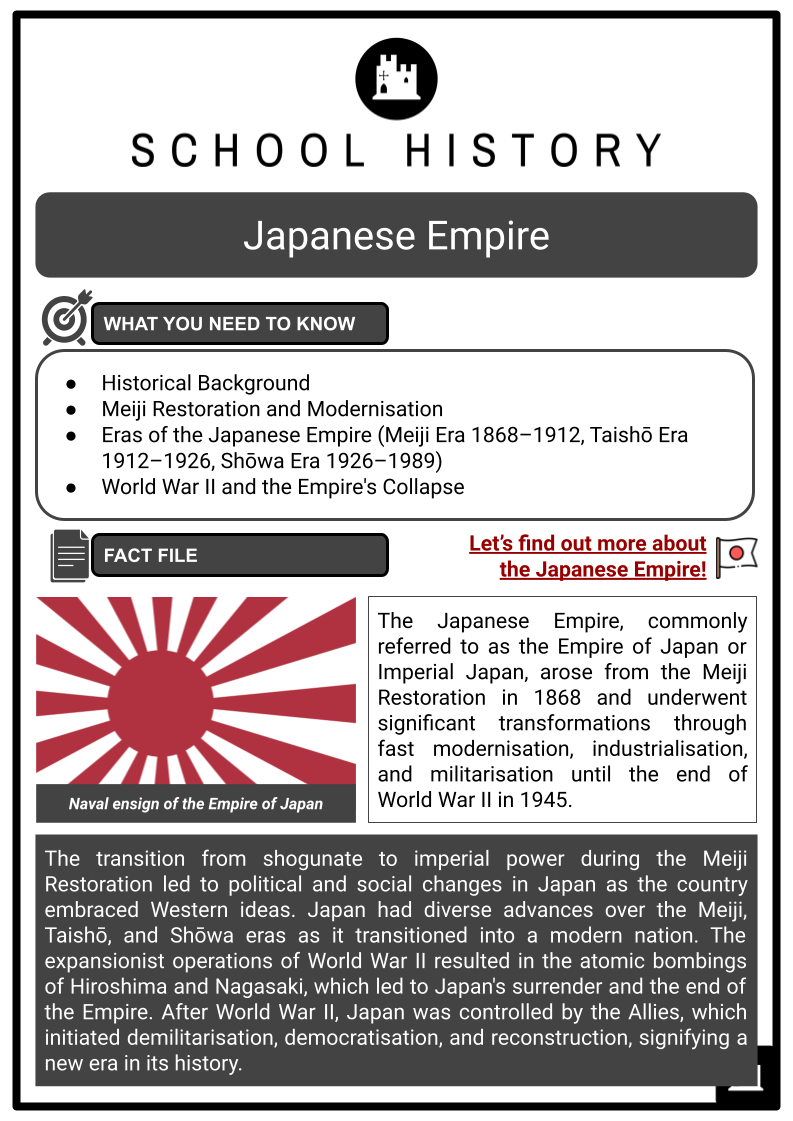
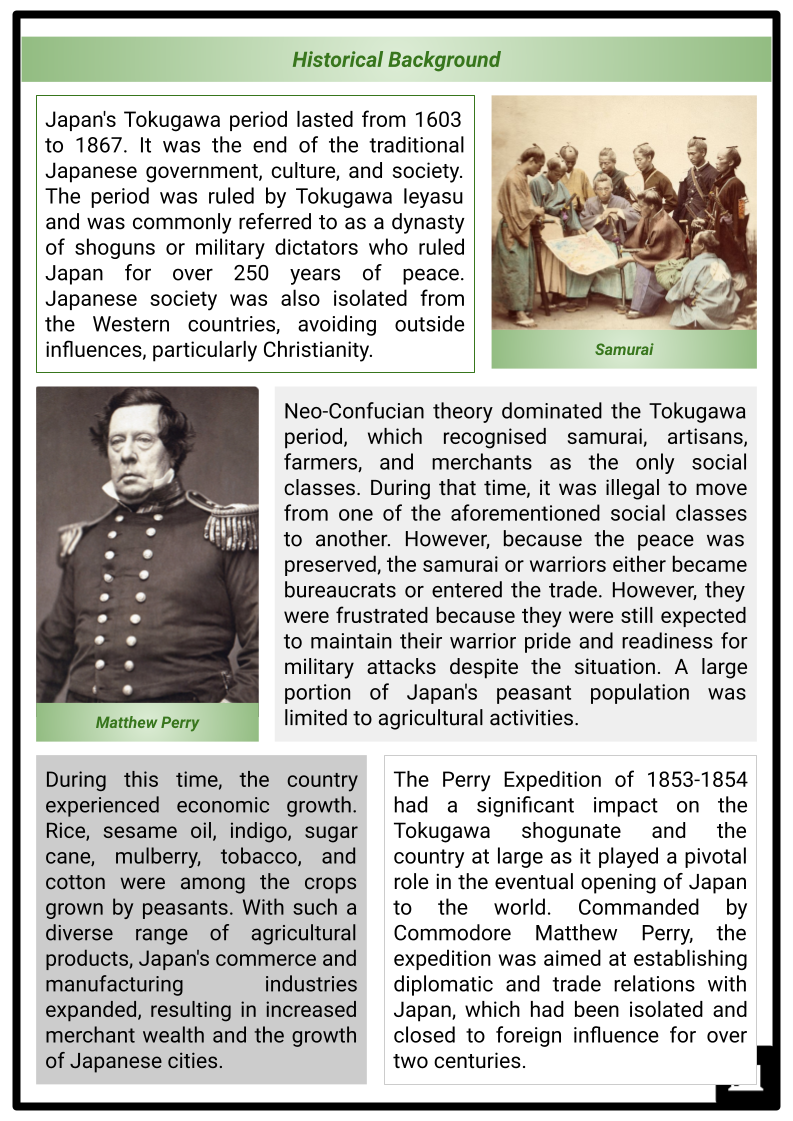
Student Activities
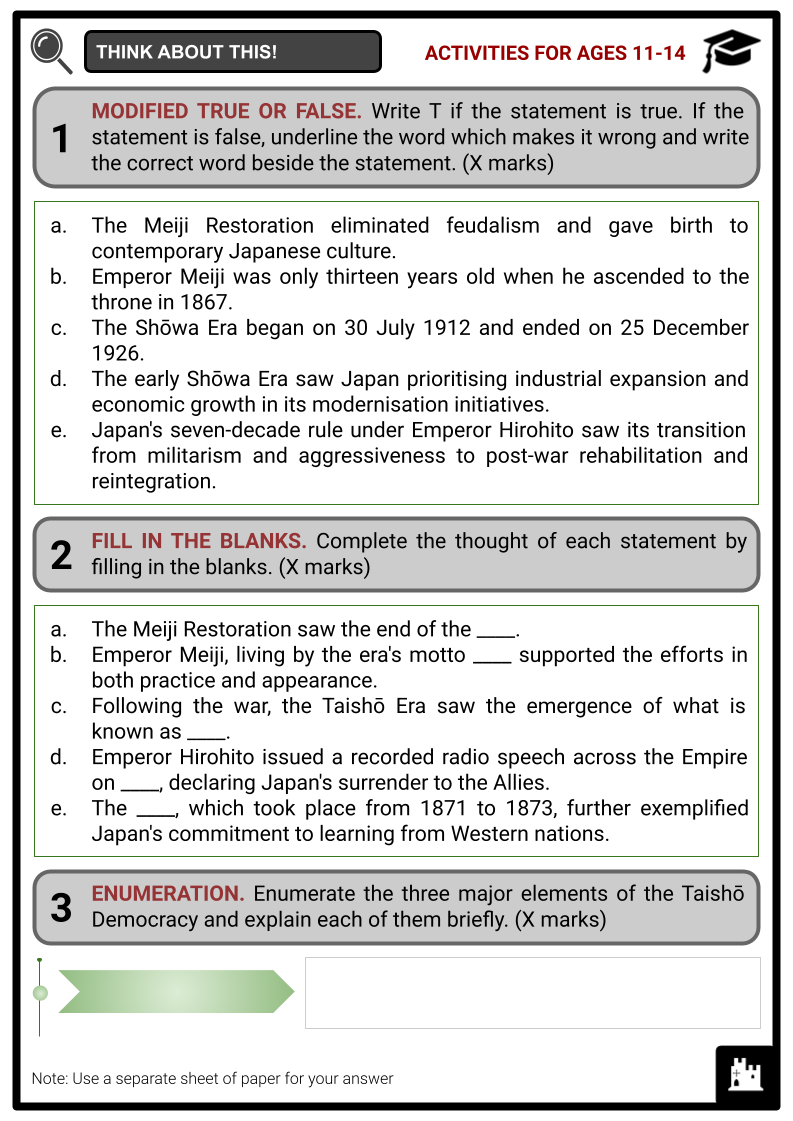
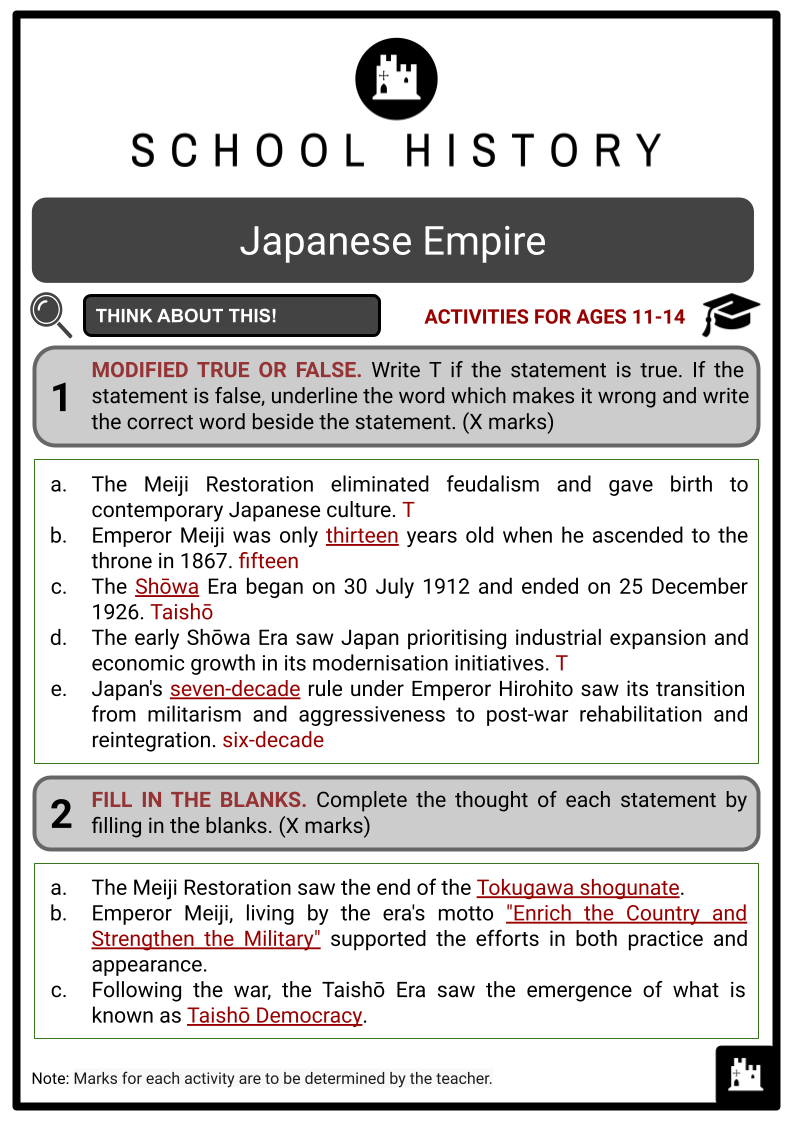
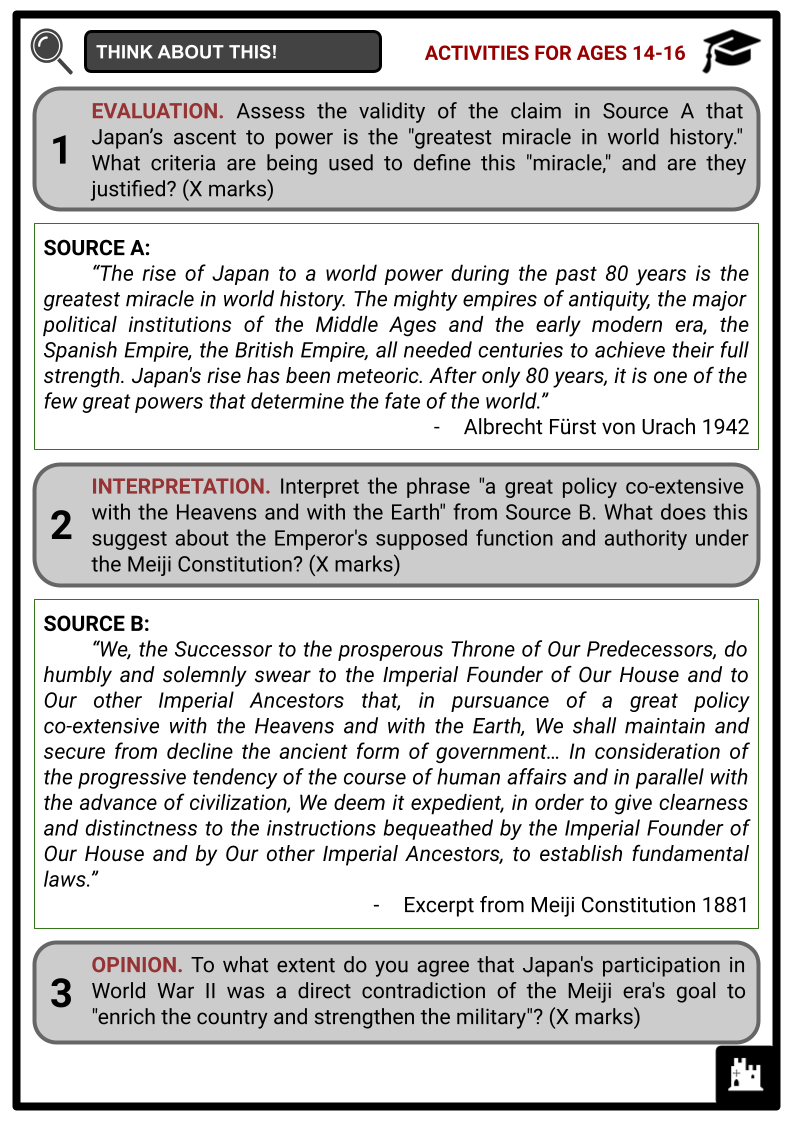
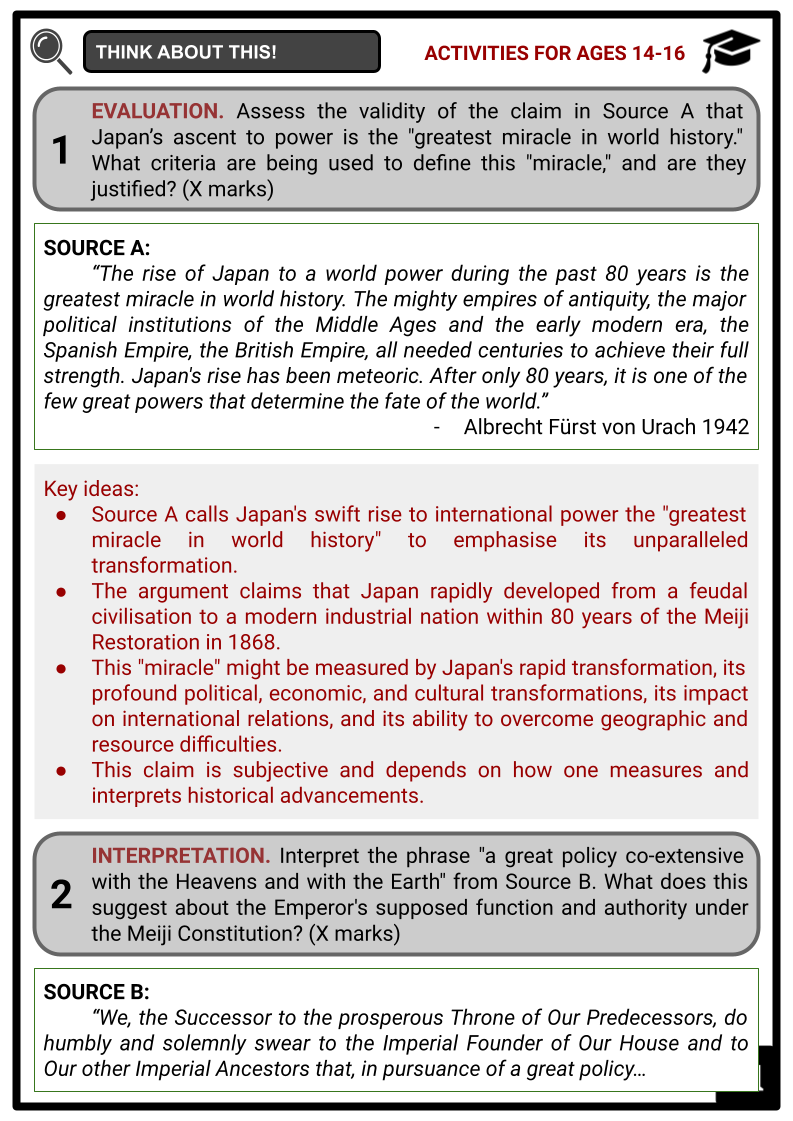
Summary
- Historical Background
- Meiji Restoration and Modernisation
- Eras of the Japanese Empire (Meiji Era 1868–1912, Taishō Era 1912–1926, Shōwa Era 1926–1989)
- World War II and the Empire's Collapse
Key Facts And Information
Let’s find out more about the Japanese Empire!
The Japanese Empire, commonly referred to as the Empire of Japan or Imperial Japan, arose from the Meiji Restoration in 1868 and underwent significant transformations through fast modernisation, industrialisation, and militarisation until the end of World War II in 1945.
The transition from shogunate to imperial power during the Meiji Restoration led to political and social changes in Japan as the country embraced Western ideas. Japan had diverse advances over the Meiji, Taishō, and Shōwa eras as it transitioned into a modern nation. The expansionist operations of World War II resulted in the atomic bombings of Hiroshima and Nagasaki, which led to Japan's surrender and the end of the Empire. After World War II, Japan was controlled by the Allies, which initiated demilitarisation, democratisation, and reconstruction, signifying a new era in its history.
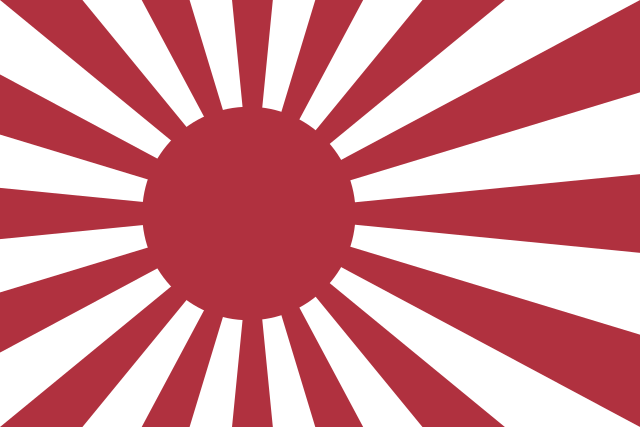
Historical Background
- Japan's Tokugawa period lasted from 1603 to 1867. It was the end of the traditional Japanese government, culture, and society. The period was ruled by Tokugawa Ieyasu and was commonly referred to as a dynasty of shoguns or military dictators who ruled Japan for over 250 years of peace. Japanese society was also isolated from the Western countries, avoiding outside influences, particularly Christianity.
- Neo-Confucian theory dominated the Tokugawa period, which recognised samurai, artisans, farmers, and merchants as the only social classes. During that time, it was illegal to move from one of the aforementioned social classes to another. However, because the peace was preserved, the samurai or warriors either became bureaucrats or entered the trade. However, they were frustrated because they were still expected to maintain their warrior pride and readiness for military attacks despite the situation. A large portion of Japan's peasant population was limited to agricultural activities.
- During this time, the country experienced economic growth. Rice, sesame oil, indigo, sugar cane, mulberry, tobacco, and cotton were among the crops grown by peasants. With such a diverse range of agricultural products, Japan's commerce and manufacturing industries expanded, resulting in increased merchant wealth and the growth of Japanese cities.
- The Perry Expedition of 1853-1854 had a significant impact on the Tokugawa shogunate and the country at large as it played a pivotal role in the eventual opening of Japan to the world. Commanded by Commodore Matthew Perry, the expedition was aimed at establishing diplomatic and trade relations with Japan, which had been isolated and closed to foreign influence for over two centuries.
- Recognising the advanced military capabilities of the United States and other Western powers, the shogunate understood the necessity of engaging with the outside world to avoid potential colonisation and maintain sovereignty. This realisation spurred internal debates and eventually led to the signing of the Convention of Kanagawa in 1854, which opened limited trade with the United States and paved the way for further international engagement. It marked the end of Japan's policy of isolation and set the stage for subsequent treaties with other foreign powers, leading to the eventual dismantling of the country's centuries-old sakoku (closed-country) policy.
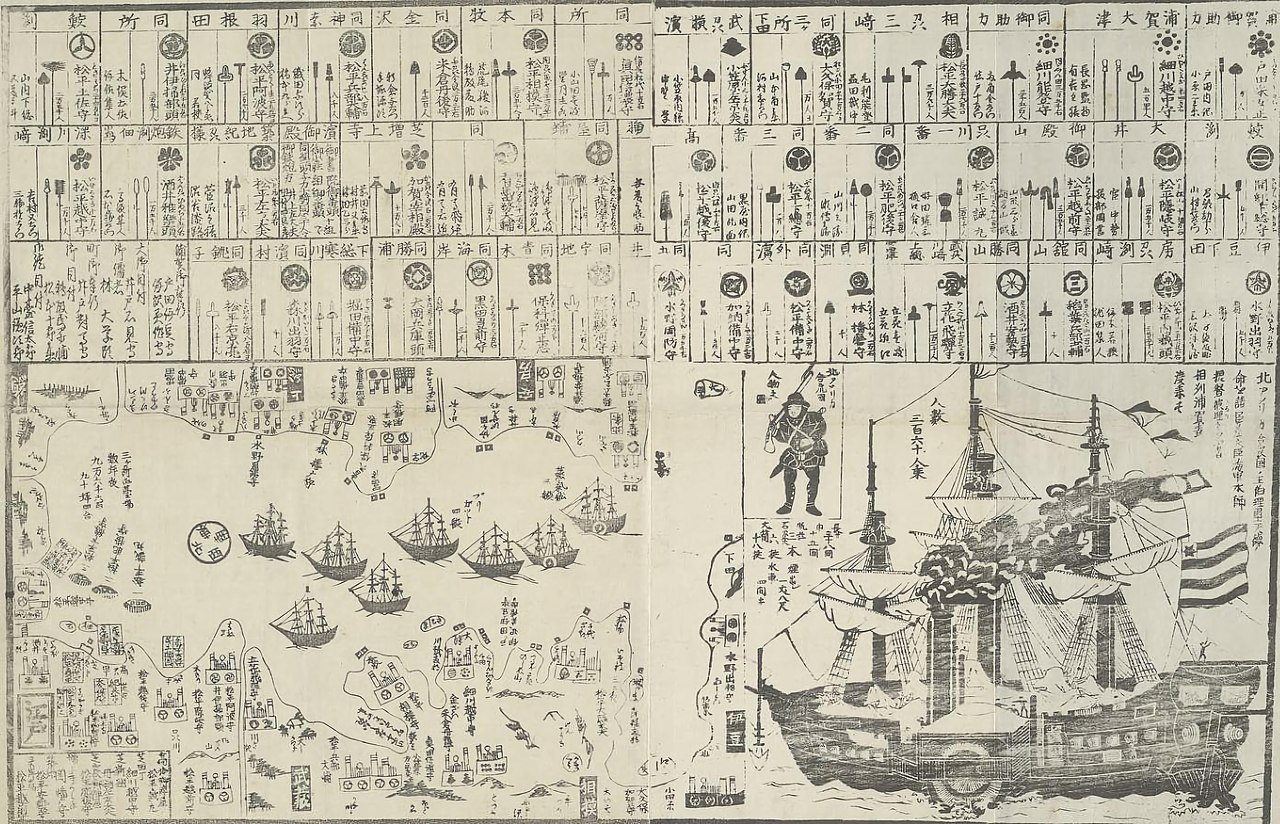
- The impact of the Perry Expedition extended far beyond the initial opening of Japan's ports. It contributed to the overhaul of traditional systems and practices, as the country eagerly adopted Western technologies, governance structures, and educational models.
- Subsequently, the Iwakura Mission, which took place from 1871 to 1873, further exemplified Japan's commitment to learning from Western nations. Led by top Japanese statesmen and scholars, the mission was a comprehensive study tour of the United States and several European countries, aiming to observe and assimilate Western political, economic, and military systems.
- This transformative shift in Japan's foreign relations laid the groundwork for the rapid modernisation and industrialisation efforts that characterised the Meiji Restoration period, setting Japan on the path to becoming a major world power.
Meiji Restoration and Modernisation
- The Meiji Restoration was a transformative period in Japanese history that was initiated in 1868. After the Tokugawa shogunate became weak, two prominent clans saw this as a chance to join forces and gain power in the name of "imperial restoration," which became known as the Meiji Restoration. It eliminated feudalism and gave birth to contemporary Japanese culture.
- The Meiji Restoration saw the end of the Tokugawa shogunate and the restoration of imperial rule under Emperor Meiji, who was only fifteen years old when he ascended to the throne in 1867; therefore, he lacked governing authority. As a result, a cabinet of advisers oversaw the new administration.
- The new cabinet set out to strengthen and unite Japan by enacting a series of reforms. Their main focus, however, was Japan's modernisation, which they saw as the key to Japan regaining its sovereignty. Even though Japan's cultural and historical roots were still evident, the West had a significant influence on the majority of reforms. The reason for emulating Western powers was to avoid colonisation and secure the independence of Japan.
- The abolition of the traditional social hierarchy based on inherited status was one of the most notable reforms. A Japanese in any one of the social classes could now freely choose to live as a farmer, warrior, merchant, or artisan. The Charter Oath, which Yuri Kimimasa wrote in 1868, made changes to the Meiji government. The document contains an outline of the new government's goals and policies and lays the groundwork for the reforms that will be implemented in the coming decades.
- The goal was to progress towards democracy, and most early reformers believed that such reforms, as well as diplomatic equality and military strength, were required to achieve that goal. Emperor Meiji, living by the era's motto "Enrich the Country and Strengthen the Military," supported the efforts in both practice and appearance. He made his appearance reflect the Western style, such as his military clothing, hairstyle, and the kaiser moustache he grew.
- The Meiji government officials also benefited from the elite band of oligarchs. Their primary goals were to strengthen the government by implementing land tax reforms and military conscription. Emperor Meiji and his oligarchs spent the next four decades making education compulsory and investing in various markets.
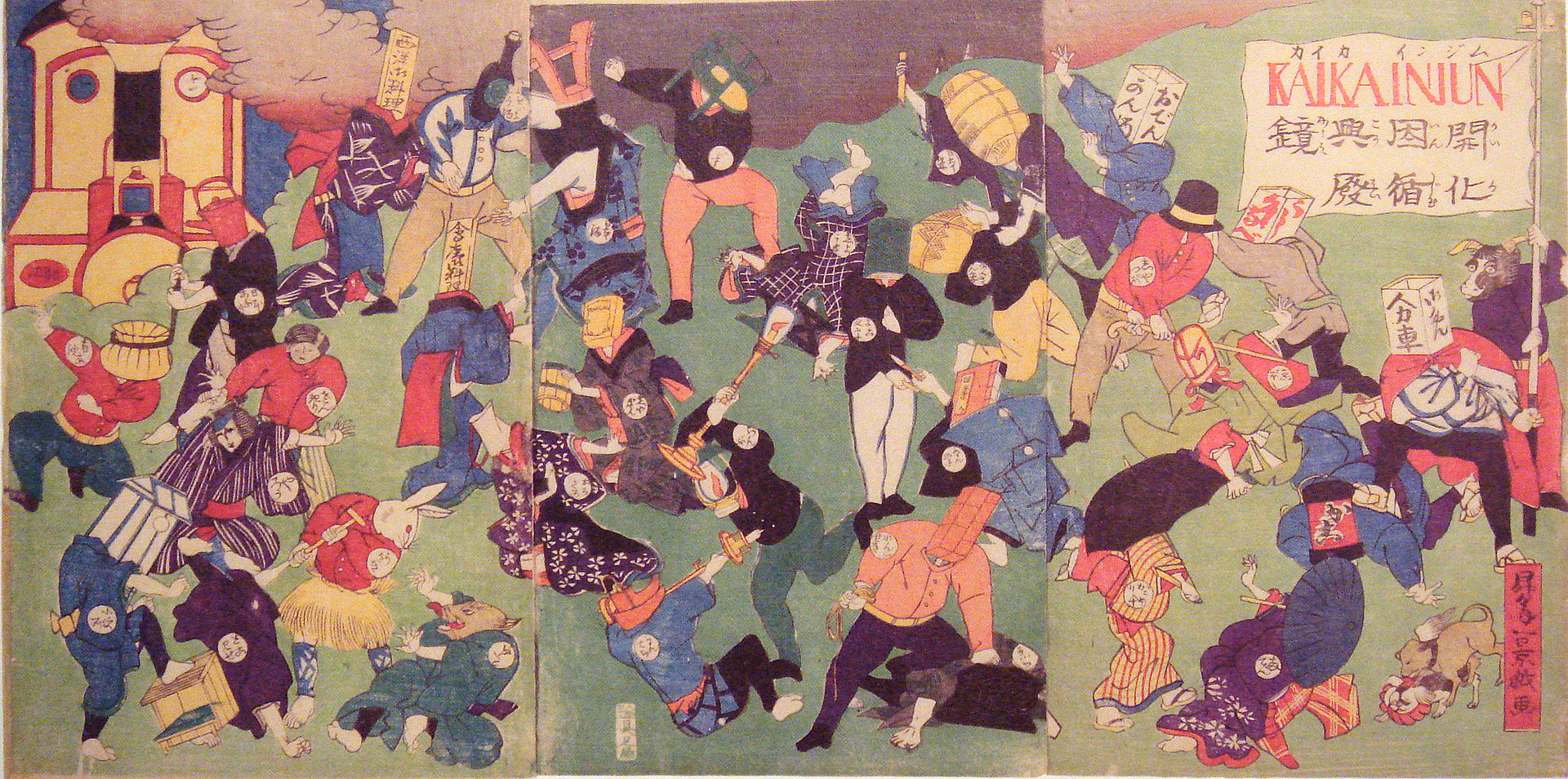
- Western-style weapons, uniforms, and even military education models were adopted. While some Japanese accepted the changes unconsciously, others actively opposed them. Visits by Japanese officials to the United States and Europe had a significant impact on the reforms.
- The Meiji Constitution was drafted in 1881 and promulgated eight years later. The constitution defines the Emperor's and all Japanese citizens' roles and responsibilities.
- However, in order to bridge the gap between the past and the present, the Meiji Constitution's authors preserved the imperial system.
- The Meiji Restoration and modernisation transformed Japan from a feudal to an industrialised nation, affecting other nations. Japan's change during this time secured its sovereignty and made it a global power. The Japanese leaders' determination and intelligence during the Meiji Restoration led to a remarkable period of reinvention and advancement.
Eras of the Japanese Empire
The Meiji Restoration led to a succession of distinct historical periods in Japan, each marked by different social, political, and cultural advancements. The Meiji, Taishō, and Shōwa eras reflect the changing identity and international influence of the Japanese Empire.
Meiji Era: 1868–1912
- The Meiji era began on 23 October 1868 and ended on 30 July 1912. The era encompasses the first half of the Empire of Japan. The most notable event was the Japanese people's transformation from an isolated feudal state-society to an industrialised nation-state.
- Since the Japanese adopted revolutionary new ideas, many aspects of Japanese society have changed dramatically, including the social structure, politics, economy, military, and foreign relations.
- Because of the abolition of feudalism, people were free to choose their occupations, creating a new environment of political and financial security. The government was in a position to invest in new industries and technologies.
- In Japan, government investments built railways and shipping lines. Telegraph and telephone networks also appeared. Many other products were produced, but the high cost of the investments put a strain on the government's finances. The newly constructed industries were sold to private investors in 1880. The newly established national education system established an elected legislature known as the Diet. This was done to achieve national growth, Western respect, and support for the modern state.
- By the end of the Meiji period, almost everyone had completed at least six years of free public schooling. The government ensured that "moral training" was included in the curriculum of schools, teaching children about their responsibilities to the emperor, the country, and their families.
- The emperor "gave" the people the 1889 constitution, and only he (or his advisers) could amend it. Beginning in 1890, a parliament was elected, although only the wealthiest of the population could vote. This was later amended in 1925 to allow all men (but not yet women) to vote.
- To gain Western legitimacy and persuade them to reverse the unequal treaties that the Japanese were forced to sign in the 1850s, Japan overhauled its whole legal system, adopting a new criminal and civil code fashioned after those of France and Germany. In 1894, the Western powers agreed to modify the treaties, recognising Japan as an equal in concept but not an international power.
- The First Sino-Japanese War, which took place between 1894 and 1895, was a significant event for Japan's emergence as a major world power. The war was fought between the Qing Dynasty of China and the Empire of Japan over influence and control of Korea. Japan's victory in the war marked the first time a modern East Asian nation had defeated a major European power. This not only demonstrated Japan's military strength but also signified its arrival as a formidable force in international affairs.
- Following the First Sino-Japanese War, the Boxer Rebellion erupted in 1899 in response to foreign influence and presence in China. The rebellion was led by a secret society known as the Boxers, who sought to rid China of foreign powers and their influence.
- Japan, alongside other Western nations, sent military forces to quell the rebellion and protect their interests in China. Japan's participation in this multinational effort further established its role as a regional power with interests beyond its own borders, particularly in the Korean peninsula.
- The Russo-Japanese War, which occurred between 1904 and 1905, was another significant conflict that further strengthened Japan's status as a global power. The war was primarily fought over rival territorial ambitions in East Asia, particularly on the Korean peninsula and Manchuria. Japan's decisive victory over the Russian Empire in this war demonstrated not only its military capabilities but also its strategic interests in Korea and the broader East Asian region.
- These significant events, such as the Meiji Restoration, Boxer Rebellion, and Russo-Japanese War, highlight Japan's transition from a feudal society to a major player in global geopolitics. During this period, Japan's keen interest in the Korean peninsula and its assertive actions exemplified its ambitions to establish itself as a dominant force in East Asia.
- The Meiji reforms brought about changes not only within Japan but also in the country's international relations. Japan was successful in retaining sovereignty, allowing them to oppose Western invaders while still expanding their colonising might. Japanese residents seeking greater social liberties embraced the post-Meiji period. This ushered in Japanese culture and a political system based on democracy.
Taishō Era: 1912–1926
- The Taishō Era began on 30 July 1912 and ended on 25 December 1926. Following the Meiji Restoration, Japan continued its modernisation efforts, focusing on internal reforms while also establishing itself as a key player on the international stage.
- During World War I, Japan, as part of the Allied Powers, primarily focused its efforts on the Asian and Pacific theatres. Japanese forces played a significant role in the successful siege of the German-controlled port of Tsingtao in China and also conducted naval operations against German colonies in the Pacific, seizing territories such as the Mariana, Caroline, and Marshall Islands.
- Following the end of the war, Japan faced challenges as it sought to expand its influence in the wake of the Russian Revolution. The country saw an opportunity to extend its territorial gains in the Far East and became involved in the Russian Civil War by supporting anti-Bolshevik forces in Siberia and the Russian Far East.
- This intervention allowed Japan to establish control over territories such as the southern part of Sakhalin Island and the Kuril Islands. However, Japan's involvement in the Russian Civil War also led to strained relations with the emerging Soviet Union.
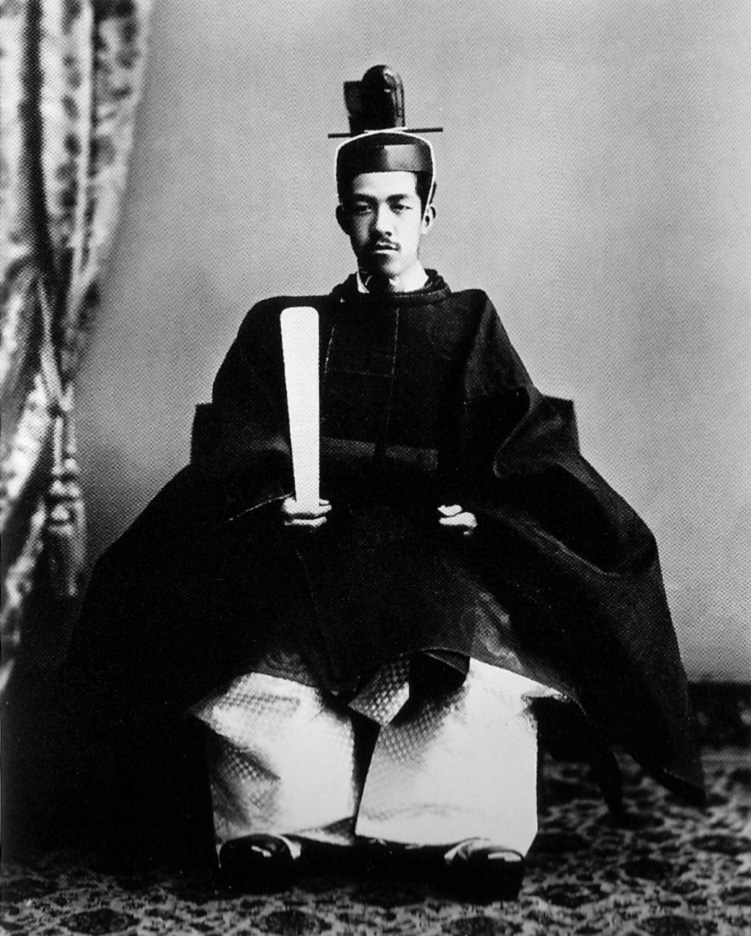
- The period of Japan's participation in WWI and intervention in the Russian Civil War solidified its status as a global power, with ambitions extending beyond its immediate region. This expansionist mindset laid the groundwork for Japan's future imperialist endeavours in the years leading up to World War II.
- After WWI, Japan's society and government changed, following the world's trend towards more political participation and civil freedoms. During the Taishō Era, democratic ideas like social equality and political groups led to the growth of a wide range of public spaces. With its new territories gained during World War I, Japan faced new foreign policy challenges and opportunities. The Taishō government handled foreign issues and tried to make Japan known as a major power while also balancing its growth in the Asia-Pacific region.
- Political leaders who were elected during the Taishō Era gained power, and the parliament became more important in making decisions about national policy. Over time, this change led to the growth of democratic institutions that made the government system more open and inclusive.
- The Taishō Era also saw the emergence of what is known as "Taishō Democracy," which was characterised by an increase in democratic activities, the rise of political parties, and a move towards more inclusive governance, though this was frequently fraught with tension and conflict.
- Three major elements of Taishō Democracy are:
- Political Liberalisation:The political atmosphere during this period became more open, with the government permitting a greater degree of political freedom. Political parties gained influence in the government, and the public became more engaged in political discourse. In 1925, universal male suffrage was introduced, which greatly increased the number of eligible voters. However, it is important to note that women were still not allowed to vote.
- Cultural Renaissance:As political developments took place, there was a cultural renaissance as new ideas about individual rights and liberties influenced philosophy, art, and literature. The urban culture in cities like Tokyo embraced modernity, as evidenced by the rise of the "modan gāru" and "mobo", symbols of Japan's engagement with Westernised lifestyles.
- Economic Growth: Japan's economy continued to develop and modernise, and alongside this came a burgeoning middle class. Although the benefits of economic growth were not evenly distributed, the middle class played a significant role in advocating for democratic reforms and the creation of a more inclusive society.
- The Taishō era set the stage for the changes that would come in the subsequent Shōwa period, which would witness the militarisation of Japan leading up to and throughout World War II.
Shōwa Era: 1926–1989
- The Shōwa Era began on 25 December 1926 and ended on 7 January 1989. Japan experienced a great deal of political, social, and cultural transformations under Emperor Hirohito's rule as the country navigated both the aftermath of World War II and years of fast modernisation.
- One notable aspect of this era was the rise of nationalism and the consolidation of economic power through the zaibatsu. Following the economic turmoil of the Great Depression in the 1930s, Japan experienced a surge in nationalist sentiment. This rise of nationalism was fueled by a desire to assert Japan's dominance in East Asia and to counter the influence of Western powers in the region.
- Under the leadership of Emperor Hirohito and the militaristic government, Japan embarked on a path of expansionism and sought to establish a Greater East Asia Co-Prosperity Sphere, aiming to create a bloc of Asian nations under Japanese hegemony.
- The zaibatsu, large industrial and financial conglomerates, played a significant role in Japan's economic landscape during the Shōwa Era. These powerful corporate entities, such as Mitsui, Mitsubishi, and Sumitomo, wielded immense influence and control over key industries, contributing to Japan's rapid industrialisation and economic growth. However, the zaibatsu's dominance resulted in economic inequalities and monopolistic behaviours, further worsening social disparities within Japanese society.
- The early Shōwa Era saw Japan prioritising industrial expansion and economic growth in its modernisation initiatives. The country became a worldwide economic power as technology and infrastructure improved its industrial foundation.
- The latter half of the Shōwa Era is closely related to Japan's World War II involvement. Japan's shift to the Axis during the war was driven by economic strife from the Great Depression, dissatisfaction with WWI's outcomes, a quest for regional influence, strained Soviet relations, the rise of fascism, and internal nationalism and militarism, motivating its aggressive expansionist policies and alignment with Germany and Italy.
- The empire's relationship with Nazi Germany and Italy cost the nation heavily in the worldwide struggle. The 1945 atomic bombings of Hiroshima and Nagasaki added to the war's devastation, prompting Japan to ponder and rebuild.
- The latter Shōwa Era also saw the coming of the Second Sino-Japanese War, which lasted from 1937 to 1945. Tensions between China and Japan had been escalating, and the Marco Polo Bridge Incident in July 1937 marked the beginning of full-scale war between the two countries. As Japan pursued its imperialist ambitions in East Asia, the conflict in China intensified, resulting in widespread devastation and atrocities committed by the Imperial Japanese Army. The invasion of China and the subsequent brutal occupation had significant implications for Japan's relations with the Western world and its standing in the international community.
- Amidst the backdrop of the Second Sino-Japanese War, Japan's ambitions for regional dominance and its aggressive expansionist policies solidified its alignment with Germany and Italy within the Axis powers during World War II. The war would ultimately culminate in Japan's defeat and the subsequent period of post-war reconstruction and reflection. The post-war Shōwa Era saw Japan's amazing restoration and economic revival. Through perseverance, the nation restored its infrastructure, revived its economy, and sought global leadership.
- As it strove to reconcile its wartime past and remake itself as a peaceful and responsible global player, Japan's international relations changed.
- Japan's six-decade rule under Emperor Hirohito saw its transition from militarism and aggressiveness to post-war rehabilitation and reintegration. During the Shōwa Era, Japan navigated significant societal, political, and cultural changes, revealing its legacy and global contributions. After Emperor Hirohito's death in 1989, Japan entered a new era, aiming to remain a dynamic, inventive, and powerful global power.
World War II and the Empire's Collapse
- The history of the Japanese Empire during World War II encompasses the aggression in Manchuria, the invasion of the Republic of China, the absorption of French Indochina, the subsequent invasion of British India, the Pacific War, and the surrender of Japan.
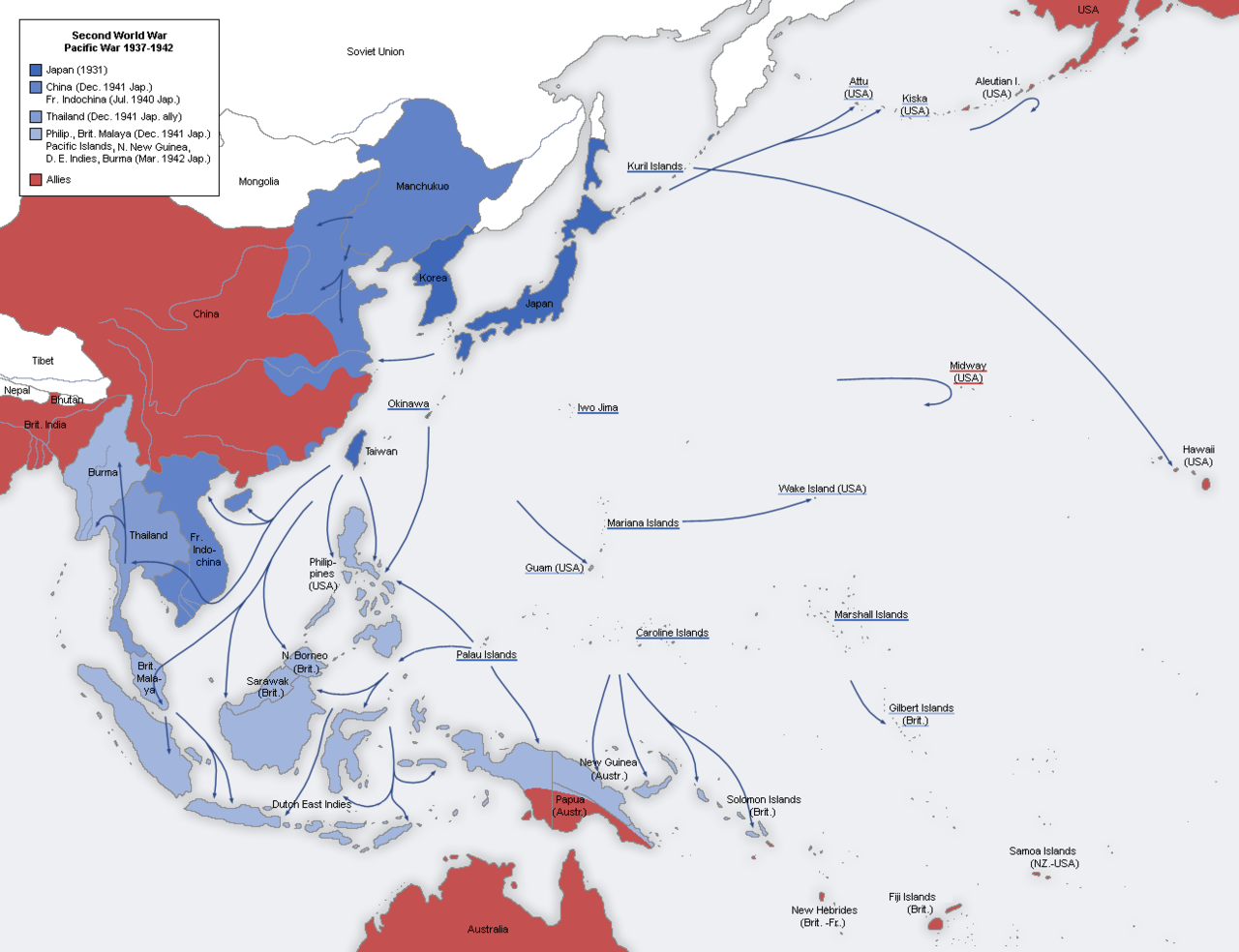
- On 7 December 1941, Japan launched simultaneous offensives against British and American colonies in Southeast Asia and the Central Pacific. The Imperial Japanese Army bombed American warships at Pearl Harbor, the Philippines, Guam, and Wake Island, as well as landings in Malaya, Thailand, and Hong Kong.
- The Americans viewed the attack as a savage and cowardly deed and rallied against the Japanese Empire. The Japanese invasion of Thailand prompted Thailand to ally with Japan, and other Japanese attacks prompted the US, UK, China, Australia, and several other states to formally declare war on Japan.
- The US launched a full-scale attack on the European and Pacific theatres, with Adolf Hitler and Benito Mussolini declaring war on the US four days later.
- Japan began offensives against the Allied forces in East and Southeast Asia, attacking British Hong Kong, British Malaya, Borneo, the Dutch East Indies, the Gilbert Islands, Thailand, and the Philippines.
- By 1942, the Japanese Empire had launched offensives in the Dutch East Indies, New Guinea, Singapore, Burma, Yunnan, India, the Solomon Islands, Timor, the Aleutian Islands, the Andaman Islands, Christmas Island, and the Solomon Sea.
- On 25 December 1941, Hong Kong surrendered to the Japanese, and the Japanese defeated an Allied army of British, Indian, Australian, and Malay forces in Malaya. The Japanese captured an estimated 80,000 Indian, Australian, and British troops as prisoners of war, and the Japanese took the late Dutch East Indies' critical oil production zones. The Battle of Midway was a decisive Allied naval victory and a significant turning point in World War II.
- The US had multiple interests in the western Pacific, including access to the Chinese market and its colonies, the Philippines, and Guam. Japan's victories in the Sino-Japanese War and the Russo-Japanese War heightened the US's hostility towards Japan. The US Navy began drafting war plans against Japan as early as 1897, later designated as the War Plan Orange. The Allies used an island-hopping strategy to invade Japan in accordance with the 1911 war plan.
- The first successful Allied leapfrogging operation was Operation Cartwheel, which involved landing on lightly held beaches with minimum fatalities while cutting off Japanese soldiers hundreds of kilometres from their supply sources. This strategy allowed US forces to reach Japan swiftly while avoiding the time, personnel, and supplies required to seize every Japanese-held island.
- From 1942 until 1945, Allied troops conducted air strikes on Japan, causing considerable damage to the country's cities and killing between 241,000 and 900,000 people.
- Strategic bombing raids began in June 1944 and lasted until August 1945, when the war ended. The US Army Air Forces campaign against Japan began in earnest in mid-1944 and accelerated in the last months of the war.
- The US, UK, and China called for the unconditional surrender of the Japanese military forces in the Potsdam Declaration on 26 July 1945. The Soviet Union declared war on Japan late in the evening of 8 August 1945, in violation of the Soviet-Japanese Neutrality Pact.
- After several days of behind-the-scenes discussions and a failed coup, Emperor Hirohito issued a recorded radio speech across the Empire on 15 August 1945, declaring Japan's surrender to the Allies. The Japanese Empire suffered greatly after the war. Devastation, economic upheaval, and a complete political and social overhaul plagued the nation. Japan began demilitarisation and democratisation following the unconditional surrender, ending its imperial ambitions and ushering in a new era under Allied rule.
- Following Japan's surrender, the Allies took several key actions to ensure the country's transformation and rehabilitation in the post-war era. One of the most significant steps was the initiation of the Allied occupation under the leadership of General Douglas MacArthur.
- As part of this process, the Allies implemented substantial reforms, including the dissolution of imperial institutions and the establishment of a new constitution. The new constitution, which came into effect in 1947, introduced fundamental changes such as the renunciation of war, the guarantee of basic human rights, and the separation of powers within the government. These reforms were pivotal in reshaping Japan's political landscape and promoting a more egalitarian and democratic society.
- Furthermore, the Allies oversaw the demilitarisation of Japan, significantly reducing the country's military capability and focusing on rebuilding its economy and infrastructure. This period witnessed extensive economic aid and support from the United States that helped in Japan's post-war reconstruction and economic revival. Through diplomatic efforts and engagement with other nations, Japan sought to reconcile its wartime past and demonstrate its commitment to contributing positively to the world.
- As a result of these comprehensive actions by the Allies, Japan underwent a remarkable transformation during the post-war period, ultimately emerging as a dynamic, innovative, and influential global power. After the Japanese Empire fell, a period of aggression and imperialism came to an end, and a new era of democracy, peace, and economic prosperity began in Japan's history.
Image Sources
- https://upload.wikimedia.org/wikipedia/commons/thumb/5/54/Naval_ensign_of_the_Empire_of_Japan.svg/640px-Naval_ensign_of_the_Empire_of_Japan.svg.png
- https://upload.wikimedia.org/wikipedia/commons/thumb/c/ce/Japanese_1854_print_Commodore_Perry.jpg/1280px-Japanese_1854_print_Commodore_Perry.jpg
- https://upload.wikimedia.org/wikipedia/commons/thumb/8/87/The_New_fighting_the_Old_in_early_Meiji_Japan_circa_1870.jpg/1920px-The_New_fighting_the_Old_in_early_Meiji_Japan_circa_1870.jpg
- https://upload.wikimedia.org/wikipedia/commons/5/52/Emperor_Taisho_of_Japan.jpg
- https://upload.wikimedia.org/wikipedia/commons/thumb/5/52/Second_world_war_asia_1937-1942_map_en6.png/1280px-Second_world_war_asia_1937-1942_map_en6.png
Frequently Asked Questions
- What was the Japanese Empire?
The Japanese Empire was a historical entity encompassing territories and colonies Japan controlled during the late 19th and early 20th centuries.
- How did Japan acquire its Empire?
Japan acquired its Empire through military conquest, annexation, and colonisation, often through aggressive expansionist policies.
- How did Japan's empire collapse?
Japan's empire collapsed primarily due to its defeat in World War II. Following Japan's surrender in 1945, Allied forces occupied its territories, and many territories gained independence.
